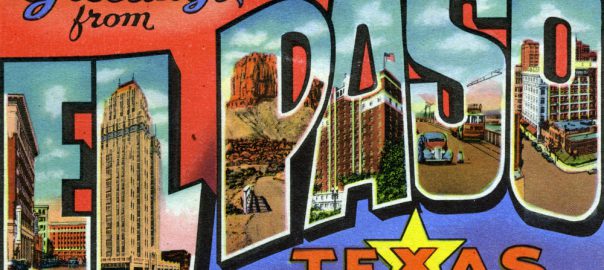Route 62 into Fayetteville ain’t what it used to be. It’s an Interstate now, and while we were tempted to try to locate the original right-of-way, we had another agenda.
An old Roadside held out the promise of a prize Valentine diner, Stevie D’s, in Shawnee, OK, about 240 miles distant. We couldn’t expect it to be open on a Sunday night, but we could spot it, learn the hours, and then breakfast there on Day Nine.
So we suffered the indignity of the Interstate, along with signage hailing a former Arkansas governor who had moved on to greater disgrace. We spun off into Farmington where an ostrich hooted at us from a pen.
We backed up to take a picture. The bird collapsed spastically, like a featherbed doing the twist. We drove away. The ostrich stood up. We backed again. The twist resumed. Everyone stops that page in our scrapbook and asks, “What in hell is this?”
The next village, Prairie Grove, had a leafy old Civil War campground and a church on the corner of Kate Smith Street. (Kate Smith was born in Philadelphia.)
At Lincoln, one family appeared to have attached a rocket to its house, and next came the deserted Shady Grove Motor Court, its dozen cabins desolate and ghostly. Across the street, a family sold pecans off the back of a pickup.
Then we came sweeping down the plain to Oklahoma. Westville. its easternmost community, showed us a distinctive slate-sided school and a road policy:
“60, No Tolerance.”
Oklahoma here was far more mountainous than we’d imagined and we were hard-pressed to tolerate 45 for a while. In industrial Muskogee, firemen were hosing down embers from what looked like a three-alarmer.
Then we came to Boynton, or would have, if it were still there. The entire community of perhaps 500 people was boarded up and abandoned. Gone. It was scary.
Lunchtime brought us to Henryetta, proud birthplace of football star Troy Aikman. We wound up at the Colonial, whose glib, string-tied proprietor knew the reach of Route 62, even with Route 66 symbols all over his walls. “I just took three ton of stone up to that Minor Nursery in Amherst,” he said. “He ain’t paid me yet so I may go up and bring ’em back.”
He meant Menne Nursery near Niagara Falls, which had landscaped our yard. We may have set foot on this gentleman’s stones before we set foot in his restaurant. He also dealt in exquisite agates of translucent blue. We purchased several for the fish tank. He said he was only kidding about Menne Nursery, whose reputation is unassailable. He also said we should rethink going to El Paso.
Route 62 joins Interstate 40 for about a dozen miles over to Okemah. We could have just driven east out of Henryetta on the original Other Road to the same place. There, Polly spotted a cut-stone semi-circular coliseum which looked like a baseball stadium, only larger, almost a quarter-mile in one dimension.
As we circled the padlocked edifice, Okemah police twice circled us, then moved on, either sizing us up as harmless or, in view of our New York State plate, geezers not to be trifled with.
Route 62 through Okemah is Woody Guthrie Street. The folk-singing, song-writing legend was born here, worked for the weekly newspaper before venturing forth to this land that was made for you and me.
Prague was next. There, Route 62 is Jim Thorpe Street, for the Native American Olympian many contend was our greatest athlete. At the second-hand shop, the proprietor confirmed that Thorpe had been an infant of Prague and gently corrected our pronunciation: It rhymes with “plague,” not “bog.”
At Meeker, we planned to turn toward Shawnee and the diner, but Polly suddenly asked “Who was Carl Hubbell?” “One of the greatest baseball pitchers ever,” said Doug. He told how Hubbell had struck out Ruth, Gehrig, Foxx, Cronin, Simmons and Lazzeri, all in a row in an All-Star Game.
“He’s from Meeker,” Polly said.
“Naw,” said Doug, now missing the turn to Shawnee.
“Check the sign,” said Polly: “Meeker, Home of Carl Hubbell.” Ballotting a few weeks later placed Hubbell among the top 50 major-leaguers of all time. Three little towns, linked only by Route 62, had each produced a giant.
Sunday was no day to go knocking on doors to ask about Carl Hubbell, so we went on diner-finding. At its address, there was only a vacant lot with a diner-sized brown patch and a sign telling of future use by a mental health clinic.
Our motel clerk said he’d heard a church had bought the diner to use as a community center, and as sun set, we found our funny Valentine at the Living Word Gospel Center, 3831 North Kickapoo St. With a dozen eggs, a pound of bacon, a jar of coffee and a loaf of bread, we could have opened it up the next morning.
Oh, and the key, it was locked.

